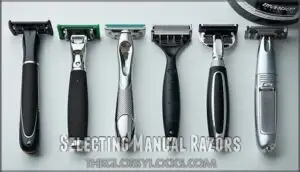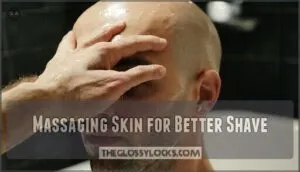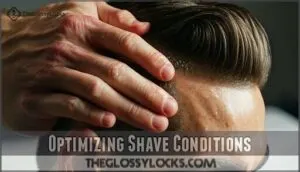This site is supported by our readers. We may earn a commission, at no cost to you, if you purchase through links.
 Proper pre shave preparation for head shaving starts with a hot shower to soften hair and open pores.
Proper pre shave preparation for head shaving starts with a hot shower to soften hair and open pores.
Clean your scalp with mild soap, then gently exfoliate to remove dead skin cells and prevent ingrown hairs.
Pat dry and apply pre-shave oil to create a protective barrier.
Follow with quality shaving cream or gel, working it into a rich lather with your hands or brush, creating the slick surface your razor needs to glide smoothly.
Trim any long hair with clippers first if needed, then proceed with shaving, as your scalp’s now primed for a comfortable, close shave that won’t leave you looking like a tomato.
Table Of Contents
- Key Takeaways
- Pre Shave Skin Prep
- Shaving Tool Selection
- Pre Shave Routine Tips
- Hand and Scalp Preparation
- Optimizing Shave Conditions
- Frequently Asked Questions (FAQs)
- How do you prepare your head for shaving?
- Is it better to shave head hair wet or dry?
- How do I prepare my hair for shaving?
- Should I oil my head before shaving?
- How often should I shave my head?
- What foods improve scalp health before shaving?
- Can I shave with acne on scalp?
- Should I shave against hair growth direction?
- How long should hair be before shaving?
- Conclusion
Key Takeaways
- Start with a hot shower and gentle cleansing – You’ll soften hair and open pores by washing your scalp with warm water and mild soap, then gently exfoliate to remove dead skin cells that can clog your razor and cause irritation.
- Apply pre-shave oil for protection – You should use 2-3 drops of jojoba or coconut oil on damp skin, massaging in circular motions to create a protective barrier that reduces friction by up to 50% during shaving.
- Trim long hair with clippers first – You’ll prevent painful pulling and razor clogging by buzzing hair to 1/4 inch or less before applying shaving cream, making your actual shave smoother and more efficient.
- Choose the right shaving products for your skin type – You need a quality shaving cream or gel with moisturizing ingredients applied in a rich lather, and if you’ve got sensitive skin, opt for alcohol-free formulas or safety razors for better control.
Pre Shave Skin Prep
Your scalp needs proper preparation before you start shaving to prevent irritation and achieve smooth results.
Clean your skin with warm water and gentle soap, then apply pre-shave products to create a protective barrier that reduces friction during the shaving process to achieve the desired outcome with minimal irritation.
Cleaning and Hydrating Skin
Before you pick up that razor, your scalp needs proper preparation.
Start with lukewarm water temperature to open pores without irritating sensitive skin. Choose a mild, pH-balanced soap for gentle cleaning.
Apply pre shave oil after washing to create a protective barrier.
Proper hydration importance can’t be overstated – moisturized skin reduces friction during head shaving prep, preventing nicks and razor burn.
Exfoliating for Smooth Shave
Once your scalp is clean and hydrated, exfoliation becomes your next power move.
This step removes dead skin cells that can clog your razor and cause irritation.
Here’s your exfoliation game plan:
- Choose gentle exfoliation methods – Use a soft-bristled brush or exfoliating scrub designed for sensitive skin
- Follow proper exfoliation frequency – Exfoliate 2-3 times per week to avoid over-scrubbing
- Select quality exfoliation products – Pick scrubs with fine granules, not harsh abrasives
- Focus on ingrown prevention – Pay extra attention to areas prone to bumps and irritation
- Time your scalp exfoliation – Always exfoliate before applying any shaving preparation products
Regular exfoliation benefits include smoother razor glide and reduced risk of nicks.
This essential step in your shaving routine sets you up for the cleanest possible shave.
Applying Pre Shave Oils
Apply 2-3 drops of preshave oils to your damp scalp for maximum oil benefits. Jojoba and coconut oil types work best for most skin sensitivity levels.
You can find pre shave oils online at various retailers.
Master proper application techniques by massaging in circular motions, allowing absorption for two minutes. This essential preshave routine creates protective lubrication during scalp preparation, making your shaving preparation smoother and safer.
Using Pre Shave Lotions or Powders
Pre shave lotion creates a protective barrier that reduces friction during your preshave routine.
Apply a thin layer to slightly damp skin, focusing on lotion ingredients like glycerin for hair softening.
Powder application works differently—it absorbs moisture while providing lubrication.
You can find the right shaving product online.
Check skin compatibility before choosing between these shaving products. Both offer excellent product benefits as alternative options for skin preparation.
Shaving Tool Selection
You’ll need to pick the right shaving tool before you start your head shaving routine, as this choice affects your comfort and results.
Consider your skin sensitivity, experience level, and time preferences when choosing between electric shavers, manual razors, and safety razors.
Choosing Electric Shavers
Electric shavers offer distinct advantages for head shaving.
Foil vs Rotary designs affect cutting performance – foil shavers provide closer shaves while rotary models navigate scalp contours better.
Consider Corded vs Cordless options based on your routine, and note that Motor Power determines efficiency.
Cleaning Systems maintain hygiene, and many models offer self-cleaning programs for thorough bacterial removal.
Choose waterproof models for wet shaving with shaving cream or gel after pre shave lotion application.
Selecting Manual Razors
Manual razors offer superior control for head shaving through careful selection.
Consider blade count from two to five cartridges for ideal hair removal. Handle ergonomics with textured grips prevent slipping during extended sessions.
Razor weight affects precision and maneuverability around scalp contours. Pivot design allows flexible movement across curved surfaces.
Many prefer to buy manual head razors for shaving. Choose stainless steel blade material for durability and pair with quality shaving cream for best results.
Safety Razors for Sensitive Skin
Safety razors transform head shaving for sensitive skin through precision engineering. Unlike cartridge razors, these classic tools offer superior control over blade aggressiveness and razor weight distribution.
The adjustable blade angle prevents razor burn while proper handle material guarantees steady grip during delicate scalp navigation.
- Choose platinum-coated blades for smoother glide and reduced friction
- Select adjustable razors to control blade aggressiveness based on skin sensitivity
- Opt for weighted handles that improve shaving angle precision
- Replace blades every 3-5 shaves to maintain peak performance
- Use with quality shaving cream for enhanced protection and lubrication
Pre Shave Routine Tips
You’ll need to establish a consistent routine that prepares your scalp and hair for the smoothest possible shave.
These essential steps work together to soften hair, open pores, and create the ideal conditions for your razor to glide effortlessly across your head, which helps to achieve a shave with the least amount of irritation, making the smoothest possible shave a reality.
Massaging Skin for Better Shave
Before applying shaving cream, massage your scalp using circular motions for two to three minutes.
This massage duration enhances follicle stimulation and improves skin elasticity, creating ideal conditions for preshave preparation.
The scalp massage increases product absorption of shaving gel while boosting blood circulation.
Focus gentle pressure across all areas to maximize shaving lubrication benefits.
Softening Hair With Warm Water
Warm water acts as your secret weapon for pore opening and follicle relaxation.
A three-minute shower duration or hot towel application achieves ideal hair hydration before applying shaving cream.
The heat softens stubborn stubble, making your preshave preparation more effective, and this beard softening technique transforms tough whiskers into manageable strands.
This transformation sets you up for superior shaving techniques and smoother results.
Applying Shave Gel or Cream
Once your hair’s softened, shave cream becomes your best friend. Choose products designed for sensitive skin to avoid irritation.
Apply a thin layer using gentle circular motions – thick cream thickness clogs razors and wastes product. Quality lather application creates essential shaving lubrication between blade and scalp.
For ideal results, allow cream to sit for a minute or two.
Ingredient benefits include moisturizers and protective oils that reduce friction during shaving.
Trimming Long Hair With Clippers
Before diving into the shaving process, you’ll need to tackle those longer locks with hair clippers.
This essential shaving preparation step prevents painful pulling and tugging during your DIY head shaving session.
Choose appropriate clipper guard sizes based on your hair length goals.
- Select corded vs cordless clippers depending on your mobility needs
- Start hair trimming with longer guards, then work down gradually
- Maintain proper clipper maintenance by cleaning blades between passes
Hand and Scalp Preparation
Start with clean hands by washing them thoroughly with soap and warm water for at least 20 seconds to prevent bacteria from contaminating your scalp.
Next, clean your scalp with a mild soap and warm water to remove oils, dirt, and dead skin cells that can interfere with a smooth shave.
This process helps ensure that you have clean hands and a prepared scalp for the next steps.
Washing Hands Thoroughly
Clean hands prevent bacteria from contaminating your scalp during shaving.
Wash with soap for twenty seconds—sing "Happy Birthday" twice to guarantee proper handwashing duration. This simple step maximizes soap effectiveness for bacteria removal.
Hygiene importance can’t be overstated when preventing infection around sensitive areas.
Your shaving cream and shaving gel work better on clean skin when you’ve eliminated surface contaminants first. To further enhance your shave, consider pre-shave skin exfoliation, which is a key step for a smooth shave and overall skin health, and remember that clean skin is essential.
Cleaning Scalp With Mild Soap
After proper hand hygiene, focus on scalp cleansing with lukewarm water and gentle soap.
Choose mild, pH-balanced soap ingredients that won’t strip natural oils or cause irritation. This washing frequency should occur before each shave to remove dirt and bacteria.
- Rinse thoroughly – Remove all soap residue to prevent razor drag
- Pat dry gently – Avoid harsh rubbing that irritates skin
- Check water temperature – Keep it warm, not scalding hot
Applying Shave Oil for Protection
Before reaching for your razor, consider applying shave oil as your skin’s first line of defense.
This shaving preparation step creates essential lubrication between blade and scalp.
Natural oil types like jojoba or coconut offer superior oil benefits for sensitive skin.
Apply using gentle application techniques with fingertips.
Quality shaving lubrication products reduce irritation reduction substantially, making your shaving oil investment worthwhile for smoother results.
Checking for Skin Irritations
After protecting your scalp with oils, take a moment to inspect your head for potential trouble spots.
Run your fingers across your scalp, identifying bumps, moles, or irritated areas that need extra care. This quick check prevents nicks and reduces shaving irritation on sensitive skin.
- Look for raised moles or skin tags that could catch your razor blade
- Feel for ingrown hairs or bumps that might cause scalp sensitivity during shaving
- Note any recent cuts or scratches to avoid reopening wounds while shaving
- Check behind ears and neck creases where scalp conditions often develop unnoticed
Optimizing Shave Conditions
Creating the right environment for head shaving makes the difference between a smooth, comfortable experience and one that leaves you irritated.
You’ll want to focus on maintaining proper skin temperature, using quality cleansers, and applying the right oils to reduce friction during your shave.
Maintaining Optimal Skin Temperature
Getting your skin temperature just right makes all the difference in your shave.
Warm water benefits include opening pores and softening hair follicles. The hot towel method works perfectly – apply for 3-5 minutes before shaving preparation.
Your skin should reach 98-102°F for ideal results.
Avoiding extremes prevents skin sensitivity impact, so skip scalding water that’ll leave you red and irritated, to achieve a comfortable shave with minimal irritation.
Using PH Balanced Cleansers
Balance matters when choosing cleansers for head shaving prep.
PH balanced formulations maintain your scalp’s natural defenses while preparing skin for razor contact. These gentle cleansers prevent irritation by supporting your skin’s protective barrier without stripping essential oils.
- Choose cleansers with 4.5-5.5 pH range to maintain skin barrier integrity
- Select gentle formulation products with natural pH levels for sensitive scalps
- Avoid harsh alkaline cleansers that disrupt your skin’s protective acid mantle
- Use before applying shaving cream to optimize cleanser ingredients effectiveness
Applying Natural Oils for Lubrication
Natural oils create a protective barrier that transforms your shaving experience.
Jojoba and coconut oil types offer excellent skin benefits while providing superior shave lubrication.
Apply these natural oils in thin layers using gentle circular motions for proper absorption. This application technique reduces friction by up to 50%, ensuring smooth razor glides.
Proper oil absorption prevents residue management issues while maintaining ideal shaving lubrication throughout your routine.
Many users find that argan oil absorbs quickly, making it a popular choice.
Reducing Friction With Shave Creams
Quality shaving cream creates a protective barrier between your blade and scalp.
Choose alcohol-free formulas with moisturizing cream ingredients that won’t dry out sensitive scalps.
Apply using circular motions to build proper lather consistency across your entire head.
- Gel vs. Cream: Shaving gel provides transparent coverage while shaving cream offers richer lubrication
- Application Techniques: Work product into skin using upward circular motions for maximum protection
- Blade Compatibility: Thicker lather works better with multi-blade razors, while thinner applications suit single blades
Frequently Asked Questions (FAQs)
How do you prepare your head for shaving?
Wash your hands thoroughly, then cleanse your scalp with warm water and gentle soap.
Apply pre-shave oil if you’ve got sensitive skin.
Softening hair with a hot towel for three minutes helps prepare it for the next steps.
Is it better to shave head hair wet or dry?
Wet shaving gives you the closest, smoothest results.
The moisture softens your hair and opens pores, making each stroke more effective.
Dry shaving works for quick touch-ups, but you’ll sacrifice that silky finish.
How do I prepare my hair for shaving?
Like a canvas awaiting a masterpiece, your scalp needs proper prep.
Start by washing with warm water and gentle soap to soften hair and open pores.
Apply pre-shave oil for protection, then buzz long hair with clippers first.
Should I oil my head before shaving?
Yes, you should apply pre-shave oil to your head. It creates a protective barrier, reduces friction by 40-50%, and helps your razor glide smoothly while preventing nicks and cuts.
How often should I shave my head?
Strike while the iron’s hot—shave your head every 2-3 days for best results.
Daily shaving works if you’ve got sensitive skin, while weekly intervals suit slower hair growth.
Find your sweet spot through experimentation.
What foods improve scalp health before shaving?
Foods rich in omega-3s like salmon, walnuts, and flaxseeds strengthen hair follicles.
Zinc from pumpkin seeds and lean meats supports scalp health.
Vitamin E from spinach and avocados improves circulation, making your scalp more resilient for shaving, with omega-3s and Vitamin E being key components.
Can I shave with acne on scalp?
You can shave with scalp acne, but proceed carefully.
Use a clean, sharp razor and gentle pressure. Avoid inflamed bumps directly.
Apply antibacterial aftershave and moisturizer afterward to prevent infection and promote healing.
Should I shave against hair growth direction?
For your first pass, shave with the grain to minimize irritation. If you want a closer shave, reapply cream and carefully go against the grain on your second pass.
How long should hair be before shaving?
Buzz longer hair to about 1/4 inch or less before shaving your head.
This prevents painful pulling and tugging during the shave.
You’ll get smoother results and avoid clogging your razor with excessive hair buildup.
Conclusion
Following these fundamental steps transforms your head shaving experience from a potential battlefield into a smooth operation.
Proper pre shave preparation for head shaving isn’t just about avoiding nicks and cuts—it’s about creating the ideal conditions for your blade to work efficiently.
When you invest time in cleaning, exfoliating, and applying the right products, you’ll achieve consistently better results.
Remember, a well-prepared scalp leads to a comfortable shave that leaves you looking sharp and feeling confident.












